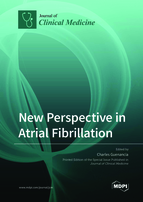New Perspective in Atrial Fibrillation
A special issue of Journal of Clinical Medicine (ISSN 2077-0383). This special issue belongs to the section "Cardiology".
Deadline for manuscript submissions: closed (20 June 2021) | Viewed by 44349
Special Issue Editor
2. PEC 2 Laboratory, EA 7460, UFR Sciences de Santé, Université de Bourgogne, Dijon, France
Interests: predictors of atrial fibrillation onset and recurrence in acute settings (sepsis, myocardial infarction, cardiac surgery, stroke): focus on atrial cardiopathy markers
Special Issue Information
Dear Colleagues,
In spite of the large volume of associated research, the pathophysiological mechanisms involved in atrial fibrillation (AF) onset and recurrence remain uncertain. This may explain why the performances of thromboembolic and bleeding prediction scores in AF patients are limited. In the past few years, the concept of atrial cardiopathy has emerged as a promising lead to connect AF to stroke, heart failure, and inflammatory processes: indeed, all of the mechanisms associated with atrial remodeling and the development of atrial cardiopathy are also likely to promote the development of AF. This recent concept of atrial cardiopathy suggests that the real trigger of stroke may be an abnormal atrial substrate rather than the atrial rhythm itself. In this setting, AF could be seen as a symptom of atrial cardiopathy rather than a risk factor of stroke. In the absence of validated clinical markers of atrial cardiopathy, the search for AF remains the cornerstone of cardioembolic stroke prevention for now.
The aim of this Special Issue is to gather basic research as well as pathophysiological and epidemiological papers focused on the relationship between atrial substrate and atrial fibrillation onset, recurrence, and outcomes.
Dr. Charles Guenancia
Guest Editor
Manuscript Submission Information
Manuscripts should be submitted online at www.mdpi.com by registering and logging in to this website. Once you are registered, click here to go to the submission form. Manuscripts can be submitted until the deadline. All submissions that pass pre-check are peer-reviewed. Accepted papers will be published continuously in the journal (as soon as accepted) and will be listed together on the special issue website. Research articles, review articles as well as short communications are invited. For planned papers, a title and short abstract (about 100 words) can be sent to the Editorial Office for announcement on this website.
Submitted manuscripts should not have been published previously, nor be under consideration for publication elsewhere (except conference proceedings papers). All manuscripts are thoroughly refereed through a single-blind peer-review process. A guide for authors and other relevant information for submission of manuscripts is available on the Instructions for Authors page. Journal of Clinical Medicine is an international peer-reviewed open access semimonthly journal published by MDPI.
Please visit the Instructions for Authors page before submitting a manuscript. The Article Processing Charge (APC) for publication in this open access journal is 2600 CHF (Swiss Francs). Submitted papers should be well formatted and use good English. Authors may use MDPI's English editing service prior to publication or during author revisions.
Keywords
- atrial fibrillation
- atrial cardiopathy
- atrial fibrosis
- atrial mapping
- autonomic nervous system
- stroke
- heart failure
- anticoagulant therapy
- thromboembolic risk
- bleeding risk







